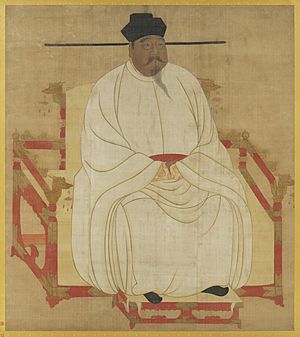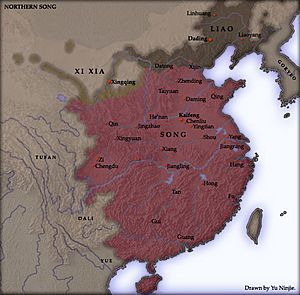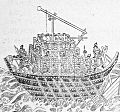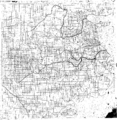Song Dynasty facts for kids
Quick facts for kids
Song
宋
|
|||||||||||||||||||||
|---|---|---|---|---|---|---|---|---|---|---|---|---|---|---|---|---|---|---|---|---|---|
| 960–1279 | |||||||||||||||||||||
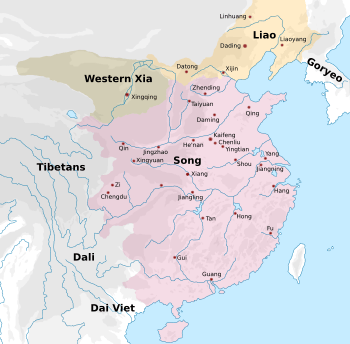
The Song dynasty at its greatest extent in 1111
|
|||||||||||||||||||||
| Capital | Bianjing (960–1127) Jiangning (1129–1138) Lin'an (1138–1276) |
||||||||||||||||||||
| Common languages | Middle Chinese | ||||||||||||||||||||
| Religion | Buddhism, Taoism, Confucianism, Chinese folk religion, Islam, Chinese Nestorian Christianity | ||||||||||||||||||||
| Government | Monarchy | ||||||||||||||||||||
| Emperor | |||||||||||||||||||||
|
• 960–976
|
Emperor Taizu (founder of Northern Song) | ||||||||||||||||||||
|
• 1127–1162
|
Emperor Gaozong (founder of Southern Song) | ||||||||||||||||||||
|
• 1278–1279
|
Zhao Bing (last) | ||||||||||||||||||||
| Historical era | Postclassical Era | ||||||||||||||||||||
|
• Established
|
February 4 960 | ||||||||||||||||||||
|
• Signing of the Chanyuan Treaty with Liao
|
1005 | ||||||||||||||||||||
|
• Alliance with Jin
|
1115–1125 | ||||||||||||||||||||
|
• Jingkang Incident
|
1127 | ||||||||||||||||||||
|
• Beginning of Mongol invasion
|
1235 | ||||||||||||||||||||
|
• Fall of Lin'an
|
1276 | ||||||||||||||||||||
|
• Battle of Yamen (end of dynasty)
|
March 19 1279 | ||||||||||||||||||||
| Area | |||||||||||||||||||||
| 958 est. | 800,000 km2 (310,000 sq mi) | ||||||||||||||||||||
| 980 est. | 3,100,000 km2 (1,200,000 sq mi) | ||||||||||||||||||||
| 1127 est. | 2,100,000 km2 (810,000 sq mi) | ||||||||||||||||||||
| 1204 est. | 1,800,000 km2 (690,000 sq mi) | ||||||||||||||||||||
| Population | |||||||||||||||||||||
|
• 1120s
|
Northern: 80-110,000,000 Southern: 65,000,000 |
||||||||||||||||||||
| GDP (nominal) | estimate | ||||||||||||||||||||
|
• Per capita
|
|||||||||||||||||||||
| Currency | Jiaozi, Guanzi, Huizi, Chinese cash, Chinese coin, copper coins, etc. | ||||||||||||||||||||
|
|||||||||||||||||||||
| Today part of | ∟ |
||||||||||||||||||||
The Song Dynasty ruled China from 960 to 1279 AD. It was a very important time. This dynasty brought China back together after a period of division. Before the Song, China was split into many small states. This time was called the Five Dynasties and Ten Kingdoms period.
In 960, a general named Zhao Kuangyin took control. He became Emperor Taizu and started the Song Dynasty. The Song Dynasty unified China again. However, its army was not very strong. They lost wars against groups like the Liao dynasty and Western Xia. After Emperor Taizu died, China faced many money and army problems.
In 1127, the Jin Dynasty attacked. They captured the Song emperor and many important people. A prince in southern China was able to escape. He became the new emperor in Hangzhou. Because of this, historians call the time before the invasion the Northern Song. The time after is called the Southern Song. The Southern Song made peace with the Jin. It lasted until Kublai Khan and the Mongols conquered all of China in 1279.
History of the Song Dynasty
Northern Song: 960–1127
The Northern Song Dynasty ruled China from 960 to 1127. The first emperor, Zhao Kuangyin, made Bianliang the capital city. Today, we call this city Kaifeng. The Northern Song period was a time of great success. China's economy and culture grew a lot during these years.
However, in 1126, the army from the Jin Dynasty began attacking Bianliang. The Northern Song Dynasty ended the very next year. The Song Dynasty was also known for its amazing buildings.
Images for kids
-
A Liao dynasty wood-carved statue of Guan Yin from Shanxi Province, China (907–1125).
-
A portrait of Emperor Gaozong of Song (ruled 1127–1162).
-
Emperor Taizu of Song, Emperor Taizong of Song, and others playing Cuju. This was an early form of football.
-
The Donglin Academy, a school like a modern college. It was built in 1111 during the Northern Song dynasty.
-
The Liaodi Pagoda, the tallest pre-modern Chinese pagoda. Built in 1055, it was a Buddhist building but also a watchtower.
-
Chinese calligraphy by Song dynasty poet Mi Fu (1051–1107).
-
Portrait of the Chinese Zen Buddhist Wuzhun Shifan, painted in 1238 AD.
-
Dried jujubes were imported to Song China.
See also
 In Spanish: Dinastía Song para niños
In Spanish: Dinastía Song para niños


